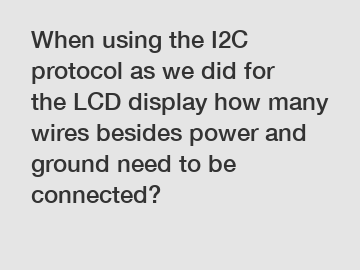When using the I2C protocol as we did for the LCD display how many wires besides power and ground need to be connected?
In the realm of electronic circuits and embedded systems, communication protocols play a crucial role, enabling devices to interact seamlessly with one another. One such protocol is the I2C (Inter-Integrated Circuit), renowned for its simplicity and efficiency. But when utilizing this protocol for connecting an LCD display, an essential question arises: besides power and ground, how many wires do we need to establish a successful connection? In this blog, we will explore this topic and provide a comprehensive understanding of the necessary wires involved.
I2C Protocol Basics:
Before delving into the wires required, let's quickly grasp the basics of the I2C protocol. Initially developed by Philips Semiconductors (now NXP Semiconductors) in the 1980s, I2C has since become widely adopted due to its ease of use. It is a synchronous, serial communication protocol that facilitates easy data transfer between devices over short distances.

The Role of SDA and SCL:
To connect devices using the I2C protocol, two key wires are indispensable: SDA (Serial Data) and SCL (Serial Clock). These wires establish a communication channel between the devices, allowing data transmission and synchronization.
1. SDA (Serial Data) Wire:
The SDA wire serves as the primary medium for transmitting data bidirectionally. It carries information sent by the transmitting device (Master) to the receiving device (Slave), as well as vice versa. As multiple devices can be connected in a daisy-chain arrangement, the SDA wire ensures the orderly transfer of data between them.
2. SCL (Serial Clock) Wire:
The SCL wire provides the necessary synchronization between the Master and Slave devices during data transmission. It operates as a timing signal, ensuring that data is correctly clocked in and out by both devices, thereby preventing data corruption. The SCL line is controlled by the Master device, responsible for generating clock pulses.
Addressing Multiple Devices:
One of the key advantages of the I2C protocol is its ability to connect multiple devices simultaneously using the same SDA and SCL lines. Each device connected to the bus possesses a unique address, allowing the Master device to communicate selectively with individual Slaves. This feature greatly economizes the number of wires required, making I2C an ideal protocol for scenarios involving numerous devices.
Additional Wires:
Besides the power, ground, SDA, and SCL wires, the exact number of additional wires necessary for an LCD display connection varies depending on the display module and any additional functionalities implemented. However, we will discuss some common scenarios:
3. Vcc and GND:
Typically, an LCD module requires a separate Vcc (power supply) and GND (ground) wire connections to ensure the required voltage levels. It is essential to provide a stable power source to facilitate the proper functioning of the display.
4. Backlight Control:
Certain LCD modules feature a backlight, allowing the display to be visible in low-light environments. In such cases, an additional wire might be required to control the backlight, typically labeled as BL. This wire connects to the backlight input pin on the module, enabling the Master device to regulate the backlight intensity.
5. Reset or Enable Wire:
To initialize or reset the LCD module, another wire, often referred to as RST (Reset) or EN (Enable), may be necessary. This wire enables the Master to trigger specific actions, such as clearing the screen or resetting the module, enhancing usability and control.
Conclusion:
In conclusion, connecting an LCD display using the I2C protocol requires a few essential wires besides power and ground. The SDA and SCL wires establish the foundation for communication, while additional wires such as Vcc, GND, backlight control (BL), and reset or enable (RST/EN) might be necessary, depending on the specific display module and features implemented. Though these wires may vary, the I2C protocol continues to be an efficient and practical choice for connecting devices, offering greater flexibility, simplicity, and ease of use.
By being aware of the wires required, you can confidently design and integrate an LCD display into your project, leveraging the power of the I2C protocol for seamless communication.
The company is the world’s best 0.96 tft display, 2 23 inch pm oled, 0.91 inch pm oled supplier. We are your one-stop shop for all needs. Our staff are highly-specialized and will help you find the product you need.

Comments